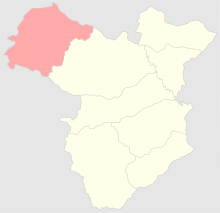Kazakhsky Uyezd
Kazakhsky Uyezd (Russian: Казахский уезд) was one of the uyezds (administrative units) of Elisabethpol Governorate of the Russian Empire and then of Azerbaijan Democratic Republic with its center in Qazax from 1868 until its formal abolition in 1929 by Soviet authorities.[1]
Kazakhsky Uyezd Казахский уезд | |
|---|---|
 Coat of arms | |
 | |
| Country | Russia |
| Political status | Uyezd |
| Region | Caucasus |
| Established | 1868 |
| Abolished | 1929 |
| Area | |
| • Total | 6,856 km2 (2,647 sq mi) |
| Population (1897) | |
| • Total | 112,074 |
| • Density | 16/km2 (42/sq mi) |
Geography
Elisabethpol Governorate consisted of Yelizavetpolsky, Nukhisky, Shusha, Zangezur, Kazakhsky, Areshsky, Dzhebrailsky and Dzhavanshirsky Uyezds.[2] Kazakh Uyezd was located in the northwestern part of Elisabethpol Governorate bordering Georgian and Erivan governorates on the north and northwest and Eslisabethpol uyezd of Elisapethpol Governorate on the east. The area of the uyezd was 6024.2 square verst. The southwestern part of the uyezd is mountainous, the northeastern part was mainly made up of lowlands. Two-thirds of uyezd was covered by Sevan or Shah-dagh mountain range of Lesser Caucasus which split Erivan with Elisabethpol governorate extending from south west towards northeast, and then meeting the Kura River in the lowlands. Among its peaks are Soyuq-bulag (Azerbaijani: Soyuğ bulağ, 8,806 ft), Shah-dagh (Azerbaijani: Şah dağ, 9556 ft), Murguz (Azerbaijani: Murğuz, 9852 ft).[3]
History
The Qazakh sultanate existed from the 15th century and was incorporated into Russian Empire along with Georgian territories. Qazakh was then a part of Georgian Governorate until the establishment of Elisabethpol Governorate in 1868. The uyezd was one of the first places where revolts against Russian rule erupted in the beginning of 1918.[4] The uyezd was abolished in 1929 by Soviet authorities and on August 8, 1930 Qazakh Rayon was created. Kazakh, also called New Akstafa was an important railway station linking Elisabethpol Governorate (Soyug Bulag station) with Erivan and Kars (Dzegam station) via Transcaucasus Railway.[3]
Population
According to a census held in 1897, the population of the uyezd was 112,074, of which 64,101 were Azerbaijani Turks, 43,555 were Armenians, 3,444 - Russians, 425 - Georgians and other minorities.[5] According to Soviet census from 1926, the population rose to 121,255 people of which 110,550 were Azerbaijani Turks, 3,632 - Armenians, 3,816 - Russians, 1,543 - Germans.[6] The uyezd ranked first in Elisabethpol Governorate for the number of its male population.[7] The population was engaged primarily in agricultural farming, gardening, and tobacco growing. Wool production played an important role in the economy of uyezd. Kazakh Uyezd had the lowest number of plants and factories in the governorate. According to statistical data from 1891, there were 10,590 horses, 2,700 donkeys and mules, 77,826 great cattle, 8,107 buffalos, 251,000 sheep, 14,100 goats, 10,468 pigs.[3]
References
- Chisholm, Hugh (1910). The Encyclopædia britannica: a dictionary of arts, sciences, literature and general information. Volume 9. Leiden, the Netherlands: The Encyclopædia Britannica Company. p. 280. ISBN 978-90-04-17901-1. Retrieved 2011-08-04.
Jevanshir.
- "Административно-территориальные реформы на Кавказе в середине и во второй половине XIX века" [Administrative-territorial reforms in Caucasus in middle and second half of 19th century]. Retrieved 2011-08-04.
- "Большой энциклопедический словарь Брокгауза и Ефрона. Казах" [Brockhaus and Efron Encyclopedia Dictionary. Kazakh]. Retrieved 2011-08-04.
- Mints, Isaac Israilevich (1971). Победа советской власти в Закавказье [The Soviet victory in Transcaucasus]. Moscow: Metsniereba. p. 423. Retrieved 2011-08-04.
- "Первая всеобщая перепись населения Российской Империи 1897 г. Распределение населения по родному языку и уездам Российской Империи кроме губерний Европейской России" [First All Russian Imperial Census of 1897. Population split according to languages spoken; uyezds of Russian empire except for governorates in European part of empire]. Archived from the original on 2012-08-19. Retrieved 2011-08-04.
- "КАЗАХСКИЙ УЕЗД (1926 г.)" [Kazakh Uyezd (1926)]. Retrieved 2011-08-04.
- Agnamaliyeva, Sevil; Kozlov, V.I. (1989). Долгожительство в Азербайджане: сборник научных трудов [Longovety in Azerbaijan: collection of scientific research]. Moscow: Institute of Ethnography named after Miklukha Maklay. Nauka. p. 84.
External links
- List of villages in Kazakh Uyezd in 1917, From Caucasian Calendar